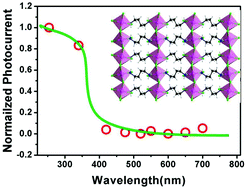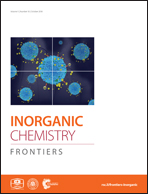(1,4-Butyldiammonium)CdBr4: a layered organic–inorganic hybrid perovskite with a visible-blind ultraviolet photoelectric response†
Abstract
Inspired by the breakthrough of three-dimensional hybrid perovskite CH3NH3PbI3, two-dimensional (2D) layered organic–inorganic halide perovskites are emerging as another promising class of hybrid materials for optoelectronic devices, such as photodetectors fabricated on lead halide perovskites. However, the majority of such 2D materials exhibit photosensitivity to visible light, while few candidates have been reported to exhibit visible-blind ultraviolet (UV) photoelectric response. Here, we present a new hybrid material, (1,4-butyldiammonium)CdBr4 (1), in which the corner-sharing CdBr6 octahedra construct the 2D perovskite-type inorganic frameworks. The optical bandgap (Eg) of 1 is estimated to be ∼3.45 eV. Particularly, 1 shows spectral-selective photoconductivity, that is, it is sensitive to UV-light illumination below 360 nm but almost blind to the standard visible light (above 400 nm), disclosing the potential of 1 for visible-blind ultraviolet photodetection. Further theoretical analyses of its electronic structure and energy gap disclose that the inorganic perovskite architecture dominates the optical bandgap. It is believed that this work provides a potential route for the design and fabrication of new 2D hybrid perovskite materials with a UV photoelectric response.



 Please wait while we load your content...
Please wait while we load your content...